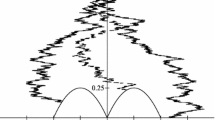Abstract
We reveal an interesting convex duality relationship between two problems: (a) minimizing the probability of lifetime ruin when the rate of consumption is stochastic and the individual can invest in a Black–Scholes financial market; (b) a controller-and-stopper problem, in which the controller controls the drift and volatility of a process in order to maximize a running reward based on that process, and the stopper chooses the time to stop the running reward and pays the controller a final amount at that time. Our primary goal is to show that the minimal probability of ruin, whose stochastic representation does not have a classical form as does the utility maximization problem (i.e., the objective’s dependence on the initial values of the state variables is implicit), is the unique classical solution of its Hamilton–Jacobi–Bellman (HJB) equation, which is a non-linear boundary-value problem. We establish our goal by exploiting the convex duality relationship between (a) and (b).
Similar content being viewed by others
References
Bayraktar, E., Young, V.R.: Minimizing the probability of lifetime ruin under borrowing constraints. Insur. Math. Econ. 41, 196–221 (2007)
Bayraktar, E., Young, V.R.: Correspondence between lifetime minimum wealth and utility of consumption. Finance Stoch. 11, 213–236 (2007)
Bayraktar, E., Young, V.R.: Mutual fund theorems when minimizing the probability of lifetime ruin. Finance Res. Lett. 5, 69–78 (2008)
Bayraktar, E., Song, Q., Yang, J.: On the continuity of stochastic exit time control problems. Stoch. Anal. Appl. 29, 48–60 (2011)
Browne, S.: Optimal investment policies for a firm with a random risk process: exponential utility and minimizing the probability of ruin. Math. Oper. Res. 20, 937–958 (1995)
Buckdahn, R., Li, J.: Probabilistic interpretation for systems of Isaacs equations with two reflecting barriers. Nonlinear Differ. Equ. Appl. 16, 381–420 (2009)
Crandall, M., Ishii, H., Lions, P.-L.: User’s guide to viscosity solutions of second order partial differential equations. Bull. Am. Math. Soc. 27, 1–67 (1992)
Duffie, D., Zariphopoulou, T.: Optimal investment with undiversifiable income risk. Math. Finance 3, 135–148 (1993)
Duffie, D., Fleming, W., Soner, M., Zariphopoulou, T.: Hedging in incomplete markets with HARA utility. J. Econ. Dyn. Control 21, 753–782 (1997)
Fleming, W.H., Souganidis, P.E.: On the existence of value functions of two-player, zero-sum stochastic differential games. Indiana Univ. Math. J. 38, 293–314 (1989)
Karatzas, I., Shreve, S.: Methods of Mathematical Finance. Springer, New York (1998)
Karatzas, I., Sudderth, W.D.: The controller-and-stopper game for a linear diffusion. Ann. Probab. 29, 1111–1127 (2001)
Karatzas, I., Zamfirescu, M.: Martingale approach to stochastic control with discretionary stopping. Appl. Math. Optim. 53, 163–184 (2006)
Karatzas, I., Zamfirescu, M.: Martingale approach to stochastic differential games of control and stopping. Ann. Probab. 36, 1495–1527 (2008)
Lions, P.-L.: Optimal control of diffusion processes and Hamilton–Jacobi–Bellman equations, Part 2: Viscosity solutions and uniqueness. Commun. Partial Differ. Equ. 8, 1229–1276 (1983)
Milevsky, M.A., Ho, K., Robinson, C.: Asset allocation via the conditional first exit time or how to avoid outliving your money. Rev. Quant. Finance Account. 9, 53–70 (1997)
Milevsky, M.A., Moore, K.S., Young, V.R.: Asset allocation and annuity-purchase strategies to minimize the probability of financial ruin. Math. Finance 16, 647–671 (2006)
Milevsky, M.A., Robinson, C.: Self-annuitization and ruin in retirement, with discussion. N. Am. Actuar. J. 4, 112–129 (2000)
Pham, H.: Continuous-Time Stochastic Control and Optimization with Financial Applications. Stochastic Modelling and Applied Probability, vol. 61. Springer, Berlin (2009)
Rogers, L.C.G., Williams, D.: Diffusions, Markov Processes, and Martingales. Cambridge Mathematical Library, vol. 2. Cambridge University Press, Cambridge (2000). Reprint of the second edition (1994)
Shreve, S., Soner, H.M.: Optimal investment and consumption with transaction costs. Ann. Appl. Probab. 4, 609–692 (1994)
Touzi, N.: Stochastic Control and Application to Finance, Scuola Normale Superiore, Pisa (2002). Special Research Semester on Financial Mathematics, Lecture Notes. Available at http://www.cmap.polytechnique.fr/~touzi/pise02.pdf
Young, V.R.: Optimal investment strategy to minimize the probability of lifetime ruin. N. Am. Actuar. J. 8, 105–126 (2004)
Zariphopoulou, T.: Consumption-investment models with constraints. SIAM J. Control Optim. 32, 59–85 (1994)
Author information
Authors and Affiliations
Corresponding author
Rights and permissions
About this article
Cite this article
Bayraktar, E., Young, V.R. Proving regularity of the minimal probability of ruin via a game of stopping and control. Finance Stoch 15, 785–818 (2011). https://doi.org/10.1007/s00780-011-0160-1
Received:
Accepted:
Published:
Issue Date:
DOI: https://doi.org/10.1007/s00780-011-0160-1
Keywords
- Probability of lifetime ruin
- Stochastic games
- Optimal stopping
- Optimal investment
- Viscosity solution
- Hamilton–Jacobi–Bellman equation
- Variational inequality




